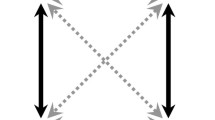Abstract
Radial isochron clocks (RICs) and their response to external signals and coupling with other RICs are studied. RICs are derived as phase approximations to self-sustained oscillators. Their response to single impulses (phase resetting) and to repetitive impulses is determined. This response may be harmonic or chaotic. Finally, the effect of coupling between clocks is studied. Simple coupling is shown to exhibit rhythm splitting like that observed in fish and small mammals. New phase locking results for general weakly coupled RIC systems are also derived.
Similar content being viewed by others
References
FitzHugh, R.: Mathematical models of excitation and conduction in nerve. Ch. I in Biological Engineering. Schwann, H. P. (ed.). New York: McGraw-Hill 1969
Keener, J. P., Hoppensteadt, F. C., Rinzel, J.: Integrate and fire models. SIAM J. on Applied Mathematics 41, No. 3, 503–517 (1981)
Guttman, R., Feldman, L.: Frequency entrainment of squid axon membrane. Preprint
Hoppensteadt, F. C.: Electrical models of neurons. In: Mathematical aspects of physiology. Hoppensteadt, F. C. (ed.). Amer. Math. Soc. Lects. in App. Math., Vol. 19, 1981
Winfree, A. T.: The geometry of biological time. Berlin-Heidelberg-New York: Springer 1980
Edmunds, L. N., Adams, K. J.: Clocked cell cycle clocks. Science 211, 1002–1013 (1981)
Winfree, A. T.: Peculiarities in the impulse response of pacemaker neurons. Math. Aspects of Physiol., ibid., 265–280
Coddington, E. A., Levinson, N.: Theory of ordinary differential equations. New York: McGraw-Hill 1955
Stefan, P.: A theorem of Sarkovskii on the existence of periodic orbits of continuous endomorphisms of the real line. Comm. Math. Phys. 54, 237–248 (1977)
Guevara, M. R., Glass, L.: Phase locking, period doubling bifurcations and chaos in a mathematical model of a periodically driven oscillator: A theory for the entrainment of biological oscillators and the generation of cardiac dysrhythmias. J. Math. Biol. 14, 1–23 (1982)
Arnol'd, V. I.: Izv. Akad. Nauk. SSSR Ser. Mat. 25, 21–86 (1961); AMS Translations, Ser. 2, 46, 213–284 (1961)
Hoffman, K.: Splitting of the circadian rhythm as a function of light intensity. Biochronometry, (Meanker, ed.) Nat. Acad. Sci., Washington, D.C. (1971) 134–151.
Rowsemitt, C. N., et al.: Photoperiodic induction of diurnal activity in Microtus Montanus. Canad. J. Zoo. in press (1982)
Herman, T.: Activity patterns and movements of subarctic voles, Oikos 29, 434–444 (1977)
Moser, J.: On the theory of quasiperiodic motions. SIAM Review 8, 145–172 (1966)
Hale, J. K.: Ordinary differential equations. (Section V.3) New York: Wiley-Interscience 1969
Keener, J. P., Hoppensteadt, F. C.: Analysis of phase locking between weakly coupled oscillators. In preparation (1982)
Author information
Authors and Affiliations
Additional information
Supported in part by the National Science Foundation under grants MCS-80-15359 (FCH) and MCS-79-02505 (JPK)
Rights and permissions
About this article
Cite this article
Hoppensteadt, F.C., Keener, J.P. Phase locking of biological clocks. J. Math. Biology 15, 339–349 (1982). https://doi.org/10.1007/BF00275692
Received:
Revised:
Issue Date:
DOI: https://doi.org/10.1007/BF00275692




